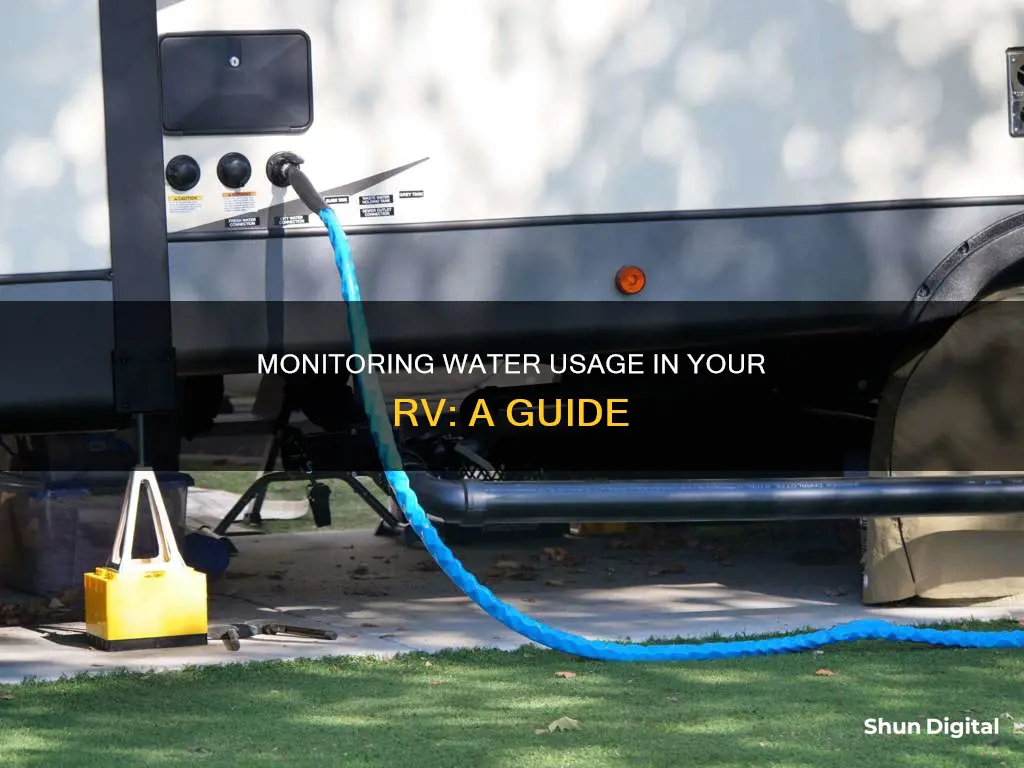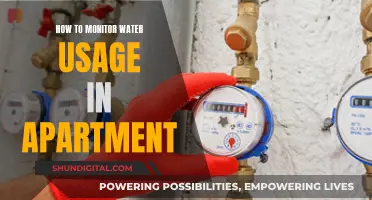
Water conservation is an important aspect of RV camping, especially if you're boondocking. To avoid cutting your trip short, it's essential to monitor and conserve water usage. While some RVs have built-in tank sensors, these are often unreliable and inaccurate. A more precise way to gauge water usage is by installing a water flow meter, which can be purchased for around $20. These devices are small, lightweight, and made of plastic. They can be easily connected to your water hose and will digitally display the amount of water flowing into your tank, helping you avoid overflow and monitor your water usage.
| Characteristics | Values |
|---|---|
| Purpose | Monitor water usage in an RV |
| Installation | Connect to the water source and hose, or plumb into the internal plumbing |
| Usage | Attach to the hose when filling the tank, or use daily to monitor water usage |
| Types | Digital water flow meter, manual measurement |
| Examples | Rainwave RW-9FM LCD Digital Water Flow Meter, P3 Save A Drop Water Flow Meter, Orbit Hose-End Water Flow Meter |
| Benefits | Accurate measurement, lightweight, small, inexpensive |
| Considerations | May need replacement over time, not suitable for extreme temperatures |
What You'll Learn

Use a digital flow meter
A digital flow meter is a great way to monitor water usage in your RV. This device is a small, lightweight, and relatively inexpensive tool that attaches to your hose and provides a digital read-out of the number of gallons flowing into your freshwater tank.
One such device is the Rainwave RW-9FM LCD Digital Water Flow Meter, which is available on Amazon for around $20. This device has a digital read-out that can be changed from gallons to litres and weighs under 3 ounces. It also features an auto-off function that turns off the display after a certain period of inactivity, saving battery life. Reviewers praise its ease of use and functionality, but some note that it is not very durable and prone to leaking.
Another option is the P3 Save A Drop Water Flow Meter, which is similar in appearance and function to the Rainwave meter but smaller and lighter. It also has an LCD digital display that is easy to read, but it lacks an automatic shut-off feature. Reviewers give it good reviews, praising its accuracy and ease of use. However, some reviewers note issues with inaccuracy in flow reporting and display issues.
A third option is the Orbit Hose-End Water Flow Meter, which is the smallest and least expensive of the three meters mentioned. Positive reviews note the accuracy of its measurements, while negative reviews cite issues with leaking, breakage, and a lack of durability.
When choosing a digital flow meter, it is important to consider factors such as ease of use, durability, accuracy, and price. Additionally, keep in mind that these devices are typically made of plastic and may need to be replaced periodically.
By using a digital flow meter, you can easily monitor your water usage in your RV, helping you conserve water and avoid overflow issues.
Monitoring Wi-Fi Usage on iPhone: A Step-by-Step Guide
You may want to see also

Monitor water levels with a gauge
Monitoring water levels with a gauge is a great way to keep track of your water usage in your RV. Here's a comprehensive guide to help you with the process:
Choosing a Water Level Gauge:
- Consider the type of gauge: The two main types of water level gauges are probe-style sensors and capacitive sensors. Probe-style sensors are the most common and cost-effective option, but they are more prone to false readings due to contamination. Capacitive sensors are more accurate and expensive and are usually found in higher-end RVs.
- Select the appropriate length: Water level gauges come in different lengths to fit different-sized tanks. Choose a gauge that is slightly shorter than the depth of your water tank. This will ensure that you have a reserve of water even when the gauge reads empty.
Installing the Water Level Gauge:
- Drill a hole in the tank: Choose a location in the tank that is approximately two-thirds from the end and a couple of inches from the side. Use a hole saw that matches the size of the gasket supplied with the level sensor. Clean up the rough edges and apply a small amount of lubricant to the gasket to ensure a good seal.
- Secure the level sensor: Tighten the level sender into place, being careful not to use too much force to avoid stripping the tank. Connect the wires from the level sensor to the RV tank level monitor panel.
- Mount the gauge: Choose a convenient location near your water fill to mount the gauge. Use a hole saw to drill a hole for the gauge. Ensure the gauge is compatible with the level sensor by checking that they have the same range of resistance.
Maintaining and Calibrating the Gauge:
- Keep sensors clean: Regularly clean the sensors to prevent build-up and contamination, which can lead to false readings. Use a sensor cleaner or a mild detergent to clean the sensors.
- Calibrate the gauge: If you want to adjust the gauge to give you more warning time before the tank is completely full, you can calibrate it by filling the tank with water and adjusting the sensor until it reads "full." Then, slowly turn it back until it turns off, and finally, turn it forward again until it glows red.
By following these steps, you can effectively monitor your water levels in your RV and make the most of your water supply during your travels.
Monitoring Power Usage: Track Your Appliance Energy Consumption
You may want to see also

Calculate usage with manual method
To calculate your daily water usage in an RV, you can use the manual method, which involves measuring the water used for various activities such as showering, washing dishes, and cooking. Here's a step-by-step guide:
- Empty your grey water tank and take a shower of your usual length.
- Transfer the grey water into a five-gallon bucket or a container with measurements.
- Make a note of how much water your shower has used by reading the measurements on the bucket or container.
- Repeat the same process for washing a typical sink full of dishes.
- Continue measuring water usage for other daily activities such as cooking.
- Add up the total amount of water used for all these activities to get your typical daily usage for non-drinking water.
- Calculate your drinking water usage by noting how much water you typically drink in a day, either at home or in your RV.
- Add your daily drinking water usage to the non-drinking water usage to get your total daily water requirement.
This manual method provides a rough estimate of your daily water usage in an RV. For a more accurate measurement, you can consider using an electronic water meter, as described in the next section.
Monitor Internet Usage: Remote Control for Online Activity
You may want to see also

Calculate usage with electronic method
A simpler and more accurate method to monitor water usage in an RV is to fit an electronic water meter to your inlet hose. This method is also known as the electronic method.
Steps to Calculate Water Usage:
- At the start of the day, fill your tank completely.
- Reset your meter or note down its reading.
- Spend a typical day in your RV, performing regular activities such as taking a shower, cooking a meal, and washing up.
- At the end of the day, refill your storage tanks while measuring how much water passes through the meter. This will give you your water usage for the day.
- For a more precise measurement, attach the water flow meter to the outlet side of your RV's water pump. This will allow you to measure a full day's water usage by performing regular activities, including showers, dishwashing, and flushing the toilet.
Benefits of Using an Electronic Water Meter:
- It provides a simple and accurate way to monitor water usage.
- It helps you keep track of your water consumption, ensuring you don't run out of water during your trip.
- It can be easily installed by screwing one end of the water flow meter onto your water hose.
- It gives you a digital read-out of the number of gallons flowing into your freshwater tank or elsewhere.
- It is small, lightweight, and relatively inexpensive.
Example of an Electronic Water Meter:
The Rainwave RW-9FM LCD Digital Water Flow Meter is a popular option for RV owners. It features a digital read-out, can measure water usage in gallons or litres, and has an auto-off feature to save battery life.
By using an electronic water meter, you can effectively monitor and manage your water usage while enjoying the freedom of RV camping.
Monitoring Internet Usage: Free LAN Solutions
You may want to see also

Monitor with a wireless system
There are a few wireless systems that can help monitor water usage in your RV. These include:
RV Whisper Monitor Station
The RV Whisper Monitor Station is a small computer that collects data from multiple Bluetooth wireless sensors in your RV. It can be installed easily by any RV owner using the included double-sided sticky Velcro, USB power cable, and USB power adapter. The monitor station logs the data to its internal database, so it's always available when you're near the RV. When connected to WiFi, the data can be viewed securely on a smartphone, tablet, or computer, and email/text alerts can also be set up.
The RV Whisper Monitor Station supports the following sensors:
- Temperature
- Shore power
- Battery voltage
- Propane levels
- Tire pressure
- Fresh, gray, and black tank levels
- Battery current and state of charge
- Door open/close
- Water leaks
- Motion sensor
- Humidity
RV Water Flow Meter
An RV water flow meter is a small device that attaches to your hose and gives a digital readout of the number of gallons flowing into your freshwater tank or elsewhere. These are generally small, lightweight, and made of plastic. They are also relatively inexpensive.
The simplest application of an RV water flow meter is to screw one end of the meter onto your water hose, which will then measure the amount of water flowing out of the hose and give you a digital readout. An advanced option would be to plumb a meter into the internal plumbing of the RV to track the amount of water flowing out of the freshwater tank.
Some popular options for RV water flow meters include:
- Rainwave RW-9FM LCD Digital Water Flow Meter
- P3 Save A Drop Water Flow Meter
- Orbit Hose-End Water Flow Meter
Monitor Smart TV Data Usage: Tips for Parents
You may want to see also
Frequently asked questions
There are two main ways to monitor water usage in an RV: the manual method and the electronic method.
The manual method involves estimating your daily water usage by emptying your grey tank and then carrying out typical daily activities such as taking a shower, washing dishes, and cooking. After each activity, you transfer the grey water into a measured container to calculate your usage.
The electronic method involves fitting an electronic water meter to your inlet hose or the outlet side of your RV's water pump. You can then measure your water usage by monitoring how much water passes through the meter during a typical day in your RV.
A water flow meter allows you to accurately track your water usage, which is particularly useful for RVers who want to monitor their water supply when dry camping or boondocking. It can also help prevent overflowing your tanks, which can cause a messy disaster inside and outside your RV.







